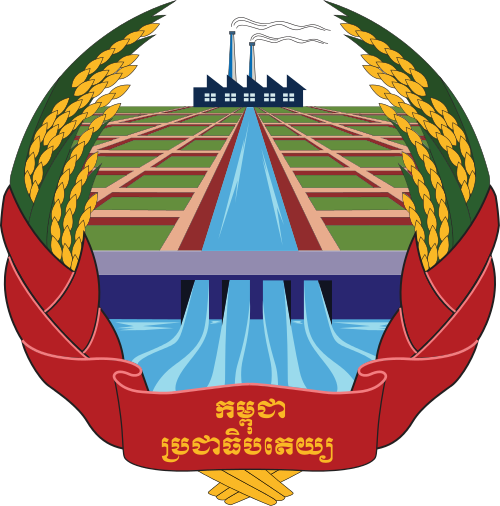The State Presidium of Democratic Kampuchea was the formal governmental body that ostensibly represented the executive branch of the state during the Khmer Rouge regime from 1975 to 1979. Although the Communist Party of Kampuchea (CPK), under the control of Angkar, held the true power in the country, the State Presidium served as the public face of governance, particularly in international relations.
The roles within the State Presidium were largely ceremonial, with little real decision-making power. The true power lay in the hands of a small group of elite leaders within the CPK’s Standing Committee, and all significant decisions were made within the Party, rather than through any government body.
Composition of the State Presidium
The State Presidium was created as part of Democratic Kampuchea’s official governmental framework, following the defeat of the Khmer Republic and the Khmer Rouge’s seizure of power in April 1975. The presidium was led by a president, and its members were appointed from within the Khmer Rouge’s upper leadership, though their roles were more symbolic than functional.
Key Members of the State Presidium:
- Norodom Sihanouk – Head of State (1975-1976)
Prince Norodom Sihanouk, the former King of Cambodia, was named Head of State after the Khmer Rouge victory in 1975. Sihanouk had allied himself with the Khmer Rouge during the civil war following his ousting by the Lon Nol regime in 1970. Despite his symbolic title as Head of State, Sihanouk had no real power under the Khmer Rouge regime. He was largely used as a figurehead to gain legitimacy both domestically and internationally. Sihanouk resigned from his position in 1976, effectively becoming a prisoner under house arrest in Phnom Penh. - Khieu Samphan – President of the State Presidium (1976-1979)
After Sihanouk’s resignation in 1976, Khieu Samphan, one of the highest-ranking Khmer Rouge leaders, was named President of the State Presidium. Though Samphan held the title of head of state, like Sihanouk before him, his role was mainly ceremonial. Khieu Samphan was closely aligned with Pol Pot and played a significant role in promoting the regime’s radical agrarian policies and isolationist foreign policy. His role as president gave him the appearance of being the leader of Democratic Kampuchea, but real power remained firmly in the hands of the CPK and Pol Pot. - Sieu Heng – Vice President of the State Presidium
Sieu Heng, who had previously been a Khmer Rouge military leader, was appointed vice president of the presidium. He played a nominal role in the governance of the state and, like others in the State Presidium, had limited influence over real policy decisions. - Chan Chakrey – Minister of Defense and Member of the State Presidium
Chan Chakrey was another key military figure who held a position within the presidium. His role was also largely ceremonial as the military and defense operations were under the direct control of Son Sen, a member of the CPK Standing Committee and Defense Minister.
Structure and Role of the State Presidium
The structure of the State Presidium mirrored that of a traditional head-of-state body, but its functions were largely confined to representing Democratic Kampuchea in diplomatic matters and providing a veneer of legitimacy to the regime’s international and domestic policies. The presidium had little involvement in the actual administration of the country, which was handled by the CPK and its network of local cadres and security forces.
The Constitution of Democratic Kampuchea, adopted on January 5, 1976, outlined the framework of the state, including the establishment of the State Presidium as the supreme executive body. In practice, however, the constitution had little bearing on how the country was governed. The real decision-making power rested with Angkar, a faceless body synonymous with the Communist Party of Kampuchea (CPK), which operated in secret.
Responsibilities
Officially, the State Presidium was tasked with:
- Representing Democratic Kampuchea in international relations
- Implementing laws passed by the People’s Representative Assembly
- Appointing ministers and other officials
- Serving as the symbolic head of the state
However, the presidium’s role was minimal in shaping policy, as all decisions were made by the CPK’s Standing Committee and implemented through Angkar.
National Anthem and Symbols
As part of the formation of the new Democratic Kampuchea government, the Khmer Rouge introduced various state symbols, including the national anthem, “Dap Prampi Mesa Chokchey” (“Glorious Seventeenth of April”), which commemorated the victory of the Khmer Rouge over the Khmer Republic and the fall of Phnom Penh on April 17, 1975. The anthem was another instrument to glorify the revolutionary cause of Democratic Kampuchea, but like the state structure itself, it existed more as a symbol than a reflection of how the regime functioned.
The use of official state symbols, such as the anthem, flag, and constitution, helped present Democratic Kampuchea as a legitimate and sovereign nation on the international stage, despite the fact that the real authority in the country operated largely in secret through the apparatus of the Communist Party of Kampuchea.
Timeline of Key Events
- April 17, 1975 – Khmer Rouge forces capture Phnom Penh, marking the end of the civil war and the fall of the Khmer Republic. The Democratic Kampuchea regime is established.
- April 25-27, 1975 – Democratic Kampuchea’s government is formed during a meeting in Phnom Penh, and the State Presidium is officially established with Prince Norodom Sihanouk as Head of State.
- January 5, 1976 – The Constitution of Democratic Kampuchea is adopted, solidifying the new governmental structure. The State Presidium, led by Sihanouk, is outlined as the head of state.
- April 1976 – Norodom Sihanouk resigns from his position as Head of State, citing disillusionment with the Khmer Rouge regime. He is placed under house arrest.
- April 11, 1976 – Khieu Samphan is appointed as the new President of the State Presidium, becoming the symbolic leader of Democratic Kampuchea.
- January 7, 1979 – Vietnamese forces invade Cambodia, capturing Phnom Penh and overthrowing the Khmer Rouge regime. The State Presidium and Democratic Kampuchea collapse, and Khieu Samphan flees along with other Khmer Rouge leaders to the Cambodian-Thai border.
Overthrow and Legacy
The State Presidium, like many other formal institutions of Democratic Kampuchea, was swept aside when Vietnamese forces invaded Cambodia in January 1979. The fall of Phnom Penh to the Vietnamese army on January 7, 1979 marked the end of Khmer Rouge rule and the effective dissolution of the presidium. Khieu Samphan and other senior Khmer Rouge leaders fled to the Thai border, where they attempted to regroup and continue resistance against the new People’s Republic of Kampuchea, which had been established by the Vietnamese-backed government.
Despite its symbolic role, the State Presidium was remembered as a largely powerless entity that served to provide legitimacy to a regime that operated in secrecy and ruled through fear. Today, the State Presidium of Democratic Kampuchea is a reminder of the complex and often obscure mechanisms of power that governed Cambodia during one of the darkest periods of its history.
Conclusion
The State Presidium of Democratic Kampuchea was a governmental body designed more for symbolic purposes than for actual governance. Its establishment and the roles of its members were largely intended to give the illusion of a functional state apparatus, while the real power lay within the Communist Party of Kampuchea and its ruling elite. Figures such as Norodom Sihanouk and Khieu Samphan played visible roles on the international stage, but their influence within the regime was minimal compared to the secretive decisions made by Angkar and the leadership of the Khmer Rouge.
This page aims to provide a detailed understanding of the State Presidium within the broader context of Democratic Kampuchea, emphasizing its ceremonial role and lack of real authority during the Khmer Rouge’s rule.









